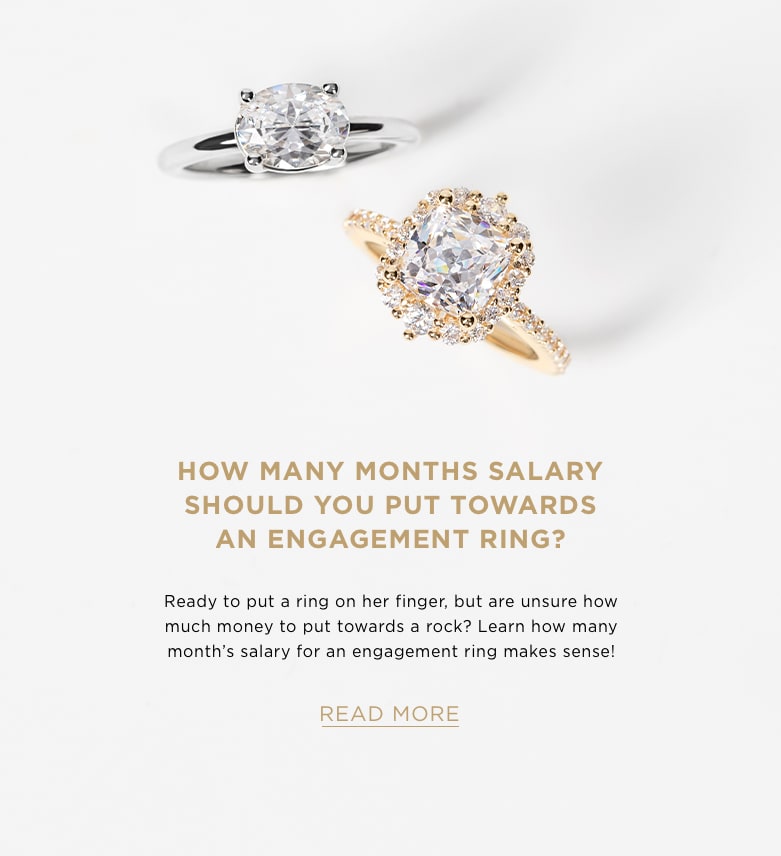Have you found “the one”? If you’ve been thinking about popping the question, the issue of how much money to put toward an engagement ring has surely crossed your mind. You’ve also probably heard whispers of a two or even three month’s salary rule that couples are traditionally expected to abide by.
In this blog, we’ll dive into the history behind the concept of the month’s salary “rule” and discuss if it still stands for modern couples when shopping for natural diamond or diamond alternative rings.

Where Did the 3 Months Salary Rule Come From?
Let’s kick things off with a little history lesson, shall we? The month’s salary adage, also known as “the engagement ring rule”, that we all know today started as a brilliant marketing campaign in the 1930s when it was dreamt up by big diamond retailer, De Beers. De Beers told consumers that diamonds were the ultimate symbol of true love and that anyone looking to propose should set aside about one month’s salary to put toward the perfect engagement ring for their future spouse. Unfortunately for our wallets, the amount Americans were told to save only began to increase as the years went on. By the 1980s the norm was two month’s worth, and since then the total engagement ring cost has been upped to three month’s salary.
Despite these guidelines, many couples are asking if this old-timey rule is even accurate for determining the average spend of an engagement ring today. And with so many choices to choose from since that ad campaign launched, it’s no wonder people are looking for the perfect engagement ring sans the budgeting nightmares.
Should You Spend Three Month’s Salary on an Engagement Ring?
According to a 2016 study by The Knot, the national average engagement ring cost is $6,163. This information correlates with a later survey conducted by Ebates that found almost half of men and women in the United States anticipate spending somewhere between $1,000 to $5,000 on diamond engagement rings plus not to mention insuring an engagement ring.
But the question still stands, should you set aside three month’s salary for a diamond ring? For some people, it might make sense, but for others, not so much. For example, if you make a gross salary of $100,000 per year, in this instance, you would be spending somewhere around $25,000 on a wedding ring. That’s bonkers! On the flip side, spending thousands of dollars on an expensive ring is simply out of the question for some shoppers making the average engagement ring cost expensive and unattainable.

How Much Should I Spend on an Engagement Ring?
Realistically, the amount that you should spend on a ring comes down to striking the perfect balance between your financial situation and your significant other’s expectations.
Remember, your partner is the person who will be wearing this ring day in and day out, so it’s important that you try to meet their expectations. Have they always dreamt about their perfect ring? Have they dished to you or their friends and family about their ideal diamond shape, cut, style, and setting? If the answer is yes, you should definitely take these things into consideration when shopping online or with a local jeweler. If your beloved hasn’t left you any hints, you can do a little detective work and try getting some details from their Pinterest board or the people closest to them.
That being said, setting an engagement ring budget is clearly a huge part of the equation. The amount of money that you can spend should be carefully considered, remember, you do not want to go into debt for a ring. Student debt, your current income, your expenses, your savings, and your potential income are all things to keep in mind before setting foot into a jewelry store.
Speaking of jewelry stores, shopping for the rings that you and your soon-to-be-fiance will wear for the rest of your life can be done for less online. There are several reliable retailers such as James Allen, Blue Nile, and White flash that sell certified, real diamonds at a fraction of the cost(around 40% less according to creditdonkey.com). Want even more phenomenal pricing? Ditching mined stones altogether is a guaranteed way to save money. Opt for a diamond alternative like moissanite or a diamond simulant instead. Alternatively, if you love the look of a diamond center stone but don’t want to pay the high price tag, look into lab-grown diamonds which are chemically and physically the same as a natural diamond in every way.
Sources:
https://www.theknot.com/content/spending-three-months-salary-on-engagement-ring
https://www.creditdonkey.com/spend-engagement-ring.html

